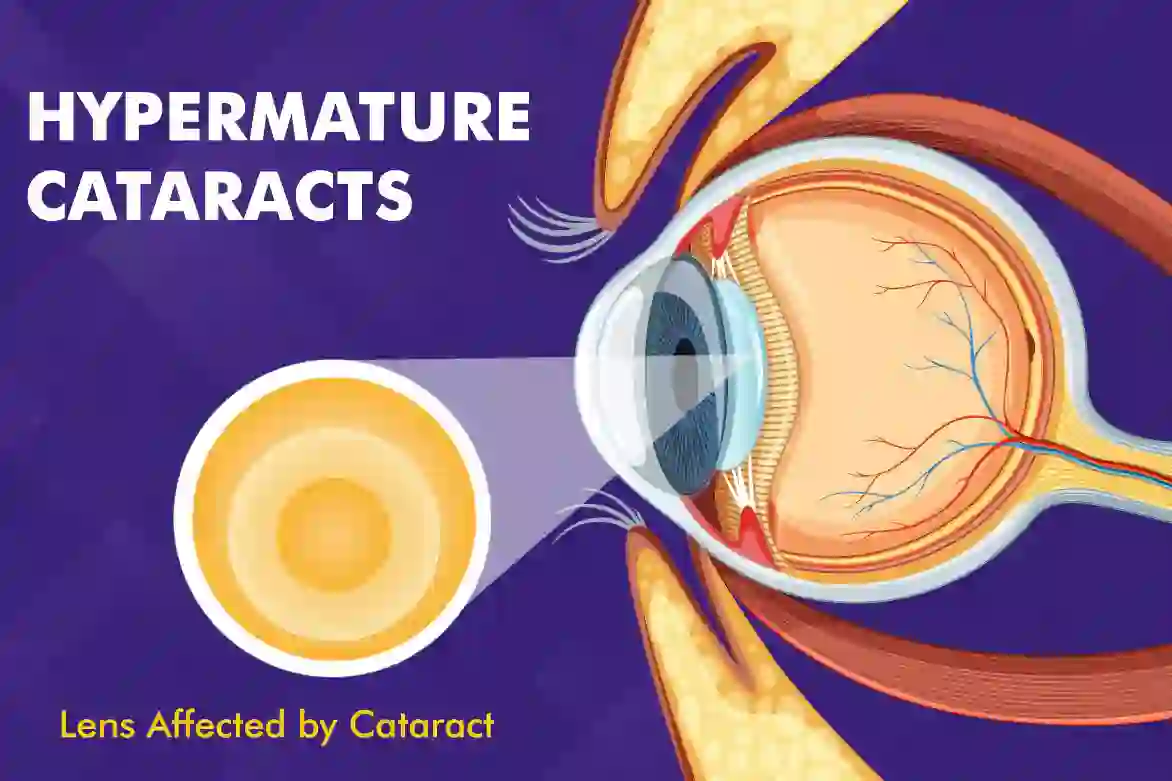For a moment, think of trying to look through a dusty windshield in a rainstorm- it feels similar to a person with a hypermature cataract. It develops due to a long standing condition of cataract which creates serious troubles.
What is hypermature cataract?
A hypermature cataract is an advanced stage of cataract development. If left untreated, it becomes dense, rigid, and opaque like a pearl. These cataracts are difficult to remove and can cause complete vision loss. Hypermature cataracts may have fluid buildup inside them. In severe cases where fluid accumulates excessively and the nucleus size decreases, it’s known as a Morgagnian cataract, which requires special treatment considerations. Additionally, untreated hypermature cataracts can lead to the development of other eye conditions and increase the risk of blindness
Causes of hypermature cataract
- Age factor: A hypermature cataract is primarily associated with aging, becoming more prevalent after the age of 60.
- Genetic influence: Genetic predisposition can play a significant role in the development of hypermature cataracts. Individuals with a family history of cataracts are at a higher risk of developing them.
- UV radiation exposure: Prolonged exposure to ultraviolet (UV) radiation without adequate eye protection can contribute to the formation of cataracts, including hypermature cataracts.
- Medical conditions: Certain medical conditions, such as diabetes, can increase the risk of developing hypermature cataracts. The impact of high blood sugar levels on lens health can accelerate cataract formation.
Know more about : Are cataracts and diabetes interrelated?
- Eye trauma: Traumatic events, such as injuries to the eye, can accelerate the development of hypermature cataracts. Damage to the eye’s structures can promote cataract formation.
- Smoking: Smoking is a modifiable risk factor associated with an increased susceptibility to cataracts, including hypermature cataracts. Chemicals in tobacco smoke can accelerate the aging process of the lens.
- Medications: Long-term use of certain medications, particularly corticosteroids, may contribute to the development of hypermature cataracts. It’s essential to discuss the potential side effects of medications with a healthcare provider.
- Previous eye surgeries: Individuals who have undergone previous eye surgeries or procedures may have an increased risk of developing hypermature cataracts. Surgical interventions can alter the structure and function of the eye, potentially leading to cataract formation.
Know the Risks of Cataract Surgery in detail.
Hypermature cataract symptoms include:
As cataracts progress to the hypermature stage, they become denser, causing significant vision impairment. Tasks such as reading, driving, and recognizing faces become increasingly challenging.
Additionally, hypermature cataracts can lead to inflammation and increased pressure within the eye, potentially causing additional eye conditions and elevating the risk of blindness.
Symptoms of hypermature cataracts can vary in severity from person to person, with some experiencing more pronounced vision loss than others. It’s essential to address hypermature cataracts promptly to prevent further complications and preserve vision.
Untreated hypermature cataracts significantly increase the risk of vision loss and blindness. Therefore, early detection and timely treatment are crucial to maintaining eye health and quality of life.
Explaining the four stages of cataracts
- Early Cataracts (Immature): Initial stage with minimal clouding of the eye’s lens.
Symptoms of early cataracts: Slight blurriness, mild visual discomfort. - Intermediate Cataracts (Mature): Description: Advancing opacity of the lens, causing noticeable vision impairment.
Symptoms of intermediate cataract: Increased blurriness, glare sensitivity. - Advanced Cataracts (Mature): Significant clouding, leading to substantial vision decline.
Symptoms of advanced cataracts: Severe blurriness, not allowing useful vision. - Hypermature Cataracts: Final stage with a fully clouded lens, impacting overall vision.
Symptoms: Progressive vision loss to the extent of blindness, only allowing perception of light.
Steps to prevent hypermature cataract
Following are some of the most effective tips to avoid hypermature cataract.
- UV Protection: Wear UV-protected sunglasses to shield eyes from harmful rays and reduce cataract risk.
- Nutrient-Rich Diet: Consume foods high in antioxidants, vitamins, and minerals for optimal eye health.
- Regular Eye Check-ups: Schedule routine eye exams to catch early signs of cataracts and address them promptly.
- Quit smoking: Kick the habit, as smoking is a modifiable factor linked to increased cataract risk.
- Manage diabetes: Control diabetes through lifestyle adjustments and medical guidance for better eye health.
- Eye safety practices: Use protective eyewear in work environments to prevent injuries that may accelerate cataract development.
- Minimize alcohol intake: Practice moderation in alcohol consumption, as excessive intake may contribute to cataract formation.
Here are some Tips to prevent cataract .
Note: There is no particular tip that guarantees to prevent hypermature cataract. However, the above mentioned steps are proven to significantly slow down hypermature cataract progression.
Diagnostic procedure for hypermature cataract
Patient history and symptom analysis: Eye doctors initiate the diagnostic journey by collecting a thorough patient history, discussing past eye-related issues and relevant medical conditions. They also scrutinize symptoms reported by the patient, such as diminished visual acuity, heightened sensitivity to light, color perception changes, and any associated discomfort.
Visual acuity examination: A meticulous visual acuity assessment using standardized eye charts is necessary for gauging both near and distance vision. This step lays the foundation for understanding the extent of vision impairment and guiding subsequent diagnostic decisions.
Slit lamp evaluation: A slit lamp is used for a detailed examination of the anterior eye segment, providing crucial insights into the opacity, density, and color of the hypermature cataract.This helps in Identifying any corneal edema or additional complications that may influence the treatment strategy.
Pupil dilation and fundus examination: This test is carried out to facilitate a clearer view of the lens and posterior eye structures by administering pupil dilation. Perform a comprehensive fundus examination to evaluate the retina, optic nerve, and overall ocular health.
Gonioscopy for glaucoma assessment: In instances of suspected secondary glaucoma, gonioscopy aids in assessing the angle between the iris and cornea. This step is vital for uncovering potential angle-closure complications associated with hypermature cataracts.
Biometry and advanced imaging: Biometry is crucial to measure axial length and calculate the optimal intraocular lens (IOL) power, essential for cataract surgery planning. Leveraging advanced imaging technologies like ultrasonography (USG) helps to obtain detailed images of the lens and surrounding structures.
Explore the Types of Intraocular Lens (IOL)
Endothelial cell count: Gauge the health of the corneal endothelium by measuring endothelial cell density, particularly relevant for surgical considerations. A decreased cell count may signify potential challenges during cataract surgery, necessitating careful planning.
Treatment options to remove hypermature cataract
Nowadays, there are different surgical and non-surgical treatment options available for hypermature cataract. Surgical options for hypermature cataract treatment are as follows:
- Extracapsular Cataract Extraction (ECCE) / SICS: It involves removing the entire lens through a single larger incision, often used for advanced cataracts or specific cases. This has largely been replaced by the more advanced phacoemulsification procedure. This is a manual procedure and hence does not require any sophisticated infrastructure or technology.
- Phacoemulsification: It utilizes ultrasound technology to break up and remove the clouded lens, requiring a small incision for faster recovery and minimal discomfort.
- Microincision Cataract Surgery (MICS): In it, the incision size is less than 1.8 mm with the purpose of reducing the surgical invasiveness, improving the surgical outcomes at the same time.
- Femto Cataract Surgery: Femto Bladeless cataract Surgery utilizes advanced laser technology for precise incisions and lens fragmentation. Differing from traditional methods, its benefits include enhanced accuracy, quicker recovery, and reduced reliance on manual techniques.
Non-surgical options for hypermature cataract treatment are:
- Medication: Although medication cannot reverse cataracts, it may be prescribed to manage associated symptoms such as inflammation or discomfort. This may include anti-inflammatory eye drops or other medications to alleviate discomfort.
It’s crucial for individuals with hypermature cataracts to visit an eye specialist to determine the most appropriate treatment plan based on their specific condition.
Complications of hypermature cataracts if left untreated
Leaving hypermature cataracts untreated for a long period may make the condition grow severe with time.
- Glaucoma: Increased intraocular pressure from the cataract can result in glaucoma, damaging the optic nerve.
- Blindness: Prolonged neglect of hypermature cataracts may ultimately lead to irreversible blindness.
- Secondary glaucoma: Fluid accumulation in the eye, if untreated, can lead to secondary glaucoma.
- Inflammatory changes: Untreated cataracts may heighten the risk of inflammation and discomfort in the eyes.
- Compromised quality of life: Impaired daily activities and reduced independence due to compromised vision.
- Secondary infections: Increased susceptibility to eye infections due to untreated cataracts.
- Chronic pain and discomfort: Persistent eye pain and discomfort can be experienced without timely treatment.
- Functional limitations: Difficulty in driving, reading, and recognizing faces, limiting overall functionality.
- Complicated surgical intervention: Delayed treatment may require more complex surgical procedures to address advanced cataracts.
- Psychological impact: Untreated hypermature cataracts may lead to reduced self-esteem and increased stress, affecting mental well-being.
Post-surgery precautions for hypermature cataracts
- Medication adherence for recovery: Stick to the prescribed post-operative medication plan to enhance recovery.
- Gentle eye care practices: Avoid eye rubbing and pressure for improved healing post-hypermature cataract surgery.
- Light shielding with sunglasses: Wear sunglasses outdoors to shield eyes from bright light during the crucial recovery phase.
- Activity moderation for eye strain prevention: Limit strenuous activities and heavy lifting to prevent strain on eyes during recovery.
- Scheduled follow-ups for monitoring: Attend scheduled follow-up appointments to closely monitor progress and address concerns.
- Want to know how to choose the best eye care centre for cataract surgery?
- Hygiene measures for reduced infection risk: Maintain eye cleanliness and hygiene practices to minimize infection risks post-surgery.
- Immediate reporting of changes: Promptly report any unexpected vision changes or discomfort to your healthcare provider.
FAQS
What is hypermature cataract?
Hypermature cataracts signify an advanced form of cataract, causing substantial opacity in the eye’s lens. Prompt management, including cataract surgery, is essential for optimal vision restoration.
What age group is more prone to hypermature cataracts?
Hypermature cataracts are more prevalent among individuals aged 60 and above. Regular eye examinations are vital in this demographic to detect and manage cataracts proactively.
How successful is the surgical removal of hypermature cataracts?
Surgical removal of a hypermature cataract is notably successful, demonstrating a high rate of effectiveness in restoring clear vision. Contemporary cataract surgery techniques, including advanced methods like phacoemulsification, ensure both safety and improved visual outcomes for individuals undergoing the procedure.
Can hypermature cataracts cause permanent vision loss?
Untreated hypermature cataracts may result in irreversible vision loss over time. Opting for timely cataract surgery is crucial to prevent permanent impairment and achieve optimal visual restoration.
How long does it take for hypermature cataracts to develop?
The development of hypermature cataracts can span several years and is influenced by factors like age, health, and genetics. Regular eye check-ups are crucial for early detection, allowing for timely intervention and proactive management.
Can hypermature cataracts be hereditary?
Yes, there is a hereditary component to hypermature cataracts. Genetic factors can contribute to an increased risk of developing cataracts. Individuals with a family history of cataracts should be vigilant and prioritize regular eye check-ups for early detection and management.
Can hypermature cataracts recur after surgical removal?
Cataract does not recur after surgical removal. Cataract surgery, involving the replacement of the affected lens with an artificial one, generally provides a lasting solution. Regular post-operative check-ups are advisable for ongoing monitoring and optimal eye health.
You can also read about Do’s and Don’ts after cataract Surgery





